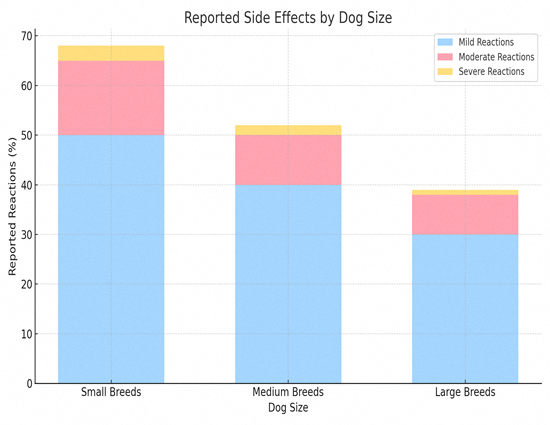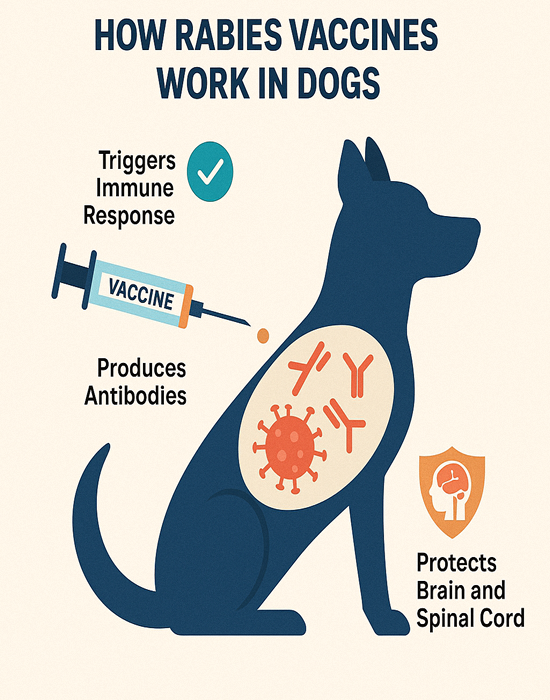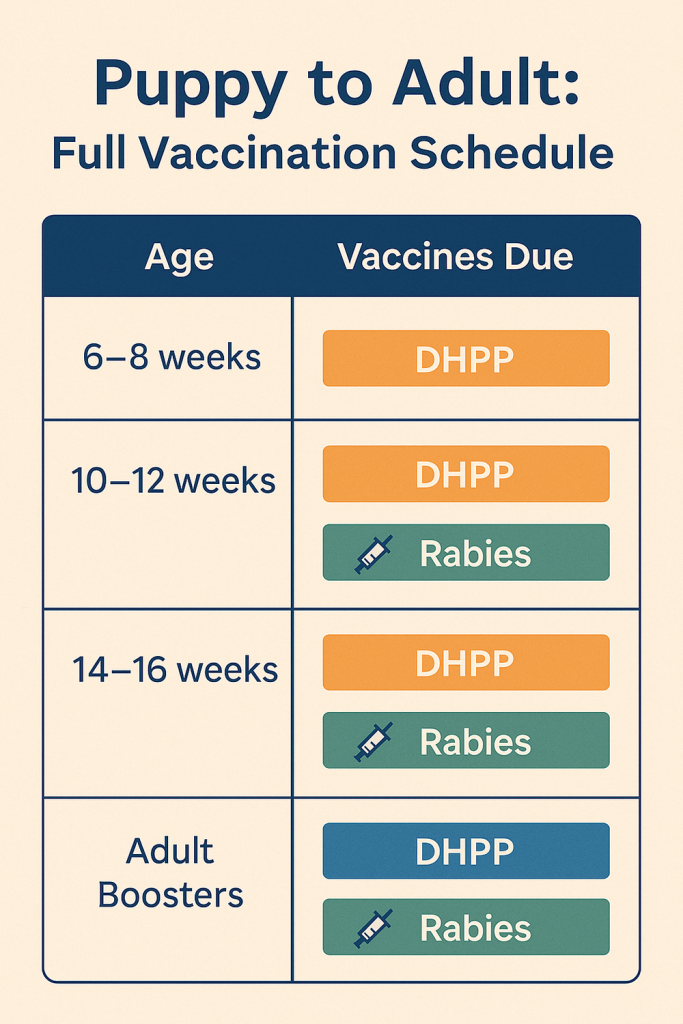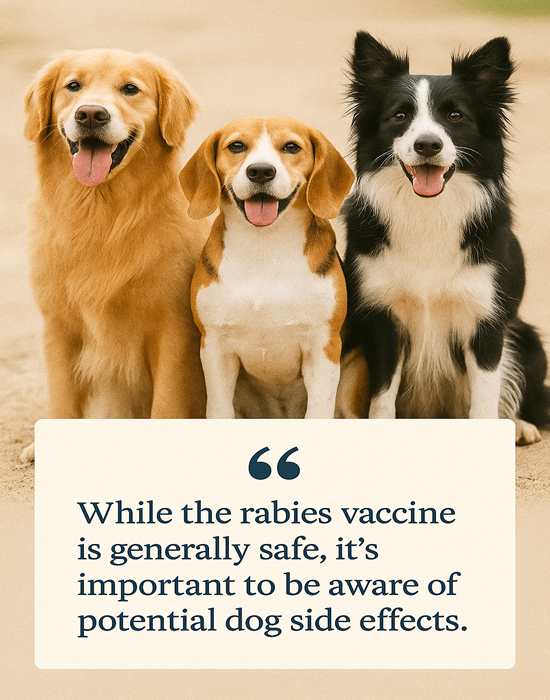Dog Side Effects of Rabies Vaccine: What Every Pet Parent Should Know

If you’ve ever worried about the dog side effects of rabies vaccine, you’re not alone. While this shot is essential in protecting our furry companions from one of the most dangerous viral diseases on the planet, many pet parents are left with questions after their dog receives it. Is it normal for your dog to act differently afterward? Should you expect mild symptoms—or be concerned about serious reactions? These are valid concerns, especially when the line between a normal immune response and something more alarming can feel unclear.
This guide dives deep into the rabies vaccine side effects in dogs, from mild symptoms to rare complications, and equips you with the knowledge to care for your dog confidently. With accurate data, real risks, and proactive tips, you’ll know exactly what to expect before, during, and after your dog’s vaccination.
Dogs Need the Rabies Vaccine
Rabies is a fatal viral disease that affects the brain and spinal cord of mammals, including humans. Once symptoms appear, rabies has nearly a 100% mortality rate. The good news? It’s entirely preventable through vaccination. According to the World Health Organization (WHO), dog-mediated rabies causes around 59,000 human deaths annually—most of which are preventable through routine dog vaccination.
In many regions, rabies vaccination is mandated by law because of its role in public health. It also helps prevent heartbreaking outcomes such as quarantine or euthanasia if a dog bites someone and isn’t up-to-date on their shots. Despite potential side effects, the rabies vaccine remains a cornerstone of responsible pet care.
Common Side Effects of Rabies Vaccine in Dogs
Mild side effects occur in about 15% of dogs and are usually short-lived. They indicate that the body is building immunity. These include:
- Lethargy or fatigue. Most dogs feel a bit tired post-vaccine, similar to how humans feel after flu shots.
- Mild fever. Slight temperature increases reflect the immune system at work.
- Soreness or swelling at the injection site. A small lump or tenderness is common and usually fades within 48 hours.
- Reduced appetite. This is typically temporary and nothing to worry about unless it persists beyond a couple of days.
- Discomfort or irritability. Some dogs may seem grumpy or sensitive, especially around the vaccination area.
These reactions are normal, and in most cases, dogs bounce back to their usual selves in no time.
Rare but Serious Side Effects to Watch For
Severe reactions are rare—estimated at less than 0.1% of cases—but they can happen. Here’s what to watch for:
- Anaphylaxis. A rapid allergic reaction that may involve vomiting, drooling, difficulty breathing, collapse, or bluish gums. It usually occurs within minutes to an hour after injection.
- Facial swelling or hives. These may be the first signs of an allergic response. Immediate vet attention is needed.
- Seizures or tremors. Especially concerning if they happen within hours of vaccination.
- Persistent high fever or weakness. Could signal immune system overactivation or infection at the injection site.
- Autoimmune reactions. In rare cases, the vaccine may trigger immune-mediated conditions like Immune-Mediated Hemolytic Anemia (IMHA) or thrombocytopenia.
Always monitor your dog closely in the hours and days following their rabies shot, especially if they’ve had vaccine reactions before.
When Do Side Effects Show Up?
Most mild dog side effects of rabies vaccine appear within 6 to 24 hours and resolve within 72 hours. Serious symptoms often manifest within the first few hours post-vaccine. Delayed reactions, although very rare, may show up several days later and require careful evaluation by a veterinarian.
“Which dogs are more at risk?” is a question that many people ask. Some dogs are more likely than others to have reactions to the rabies vaccine. Small and toy breeds, like Chihuahuas and Pomeranians, may be more sensitive simply due to their size. Very young puppies and senior dogs also tend to have weaker or less stable immune systems, making them slightly more vulnerable to vaccine-related discomfort or side effects.
Dogs that have experienced side effects from vaccines in the past should always be closely monitored, and you should alert your vet beforehand. Additionally, dogs with chronic health problems or autoimmune conditions may need a more customized vaccination plan. Receiving multiple vaccines in one visit can also increase the likelihood of side effects, so spacing them out may be a safer option for some pets.
How to Help Your Dog After the Rabies Vaccine
After your dog gets the rabies vaccine, give them a calm and cozy environment to rest. It’s normal for dogs to feel a bit tired, so avoid busy activities like long walks or dog park visits for a couple of days. Offer fresh water and a light meal, especially if your dog’s appetite is reduced. Keep an eye on the injection site—if there’s a little swelling, a cool compress can help bring it down.
Finally, monitor their behavior and energy levels for any changes. If they seem more sensitive than usual, offer gentle cuddles and reassurance. Comfort plays a big role in recovery, and your relaxed presence can make a big difference in how quickly they bounce back.
Can You Prevent or Minimize the Side Effects?
While not all dog side effects of rabies vaccine can be avoided, there are several ways to help reduce the chances your dog will experience them.
First, make sure your dog is healthy, well-rested, and not stressed before the appointment. Ask your vet if pre-treatment with antihistamines or other medications would be helpful, especially if your dog has a history of vaccine sensitivity. If your dog is scheduled for multiple vaccines, consider spacing them out over a few visits rather than combining them all at once. This gives the immune system time to respond to each one properly.
You can also ask about monovalent rabies vaccines, which only target the rabies virus and may be gentler than combination shots. Most importantly, maintain open communication with your vet and tailor your dog’s vaccine schedule to suit their individual needs.
How Rabies Vaccines Work in the Body
Rabies vaccines work by exposing your dog’s immune system to a harmless version of the rabies virus, usually a killed or inactivated form. This exposure teaches the immune system to recognize and destroy the real virus if it’s ever encountered. After vaccination, it typically takes about 7 to 14 days for full immunity to build. This internal defense not only protects your dog from developing rabies but also helps prevent the disease from being passed on to humans or other animals.
And what should you expect at the vet visit? During your dog’s rabies vaccine appointment, the vet will review your pet’s health history and perform a brief physical exam to ensure they’re fit for the shot. The injection is usually given just under the skin between the shoulder blades. The process is quick and usually causes little to no pain. Most dogs don’t even flinch. Afterward, your vet may recommend you wait in the clinic for 10–15 minutes in case of an allergic reaction. Your dog might be a little sleepy afterward, but that’s normal and should pass soon.
Why Rabies Vaccines Are Still Worth It Despite the Risks
While concerns about dog side effects of rabies vaccine are valid, the risks of not vaccinating are far greater. Rabies is a fatal disease with no cure once symptoms appear. In addition, unvaccinated dogs may face strict quarantine laws or even euthanasia if they bite someone. The rabies vaccine doesn’t just protect your dog—it protects you, your family, and your community. And when side effects do happen, they are usually minor and manageable with simple at-home care.
If you have more than one dog, it’s smart to plan your rabies vaccine appointments strategically. You might choose to stagger the shots so you can monitor each dog individually for side effects. This way, if one pet has a reaction, you won’t be overwhelmed managing multiple recoveries. Also, note each pet’s previous vaccine experiences. If one dog had a side effect in the past, it may be best to separate their appointment from the others and discuss pre-treatment options with your vet. Keeping a journal of how each dog responds to vaccines can help you and your vet tailor future visits for better safety and comfort.
When to Contact the Vet (Red Flag Checklist)
Seek veterinary help if your dog displays:
- Labored breathing or wheezing
- Swelling of the face, lips, or eyes
- Continuous vomiting or diarrhea
- Disorientation, seizures, or collapse
- High fever or shivering
- Persistent pain or lameness
- Lethargy lasting longer than 72 hours
Trust your instincts—if your dog seems “off” in a way that concerns you, call your vet.
Alternatives or Exemptions: Are They Possible?
Medical exemptions are available in some states and countries for dogs with health risks. A titer test, which measures antibody levels in the blood, may be used to determine if revaccination is necessary. However, not all jurisdictions accept titers as a substitute for a rabies vaccine, especially in legal or travel-related matters. Always check local regulations before pursuing an exemption.
Takeaways
- The dog side effects of rabies vaccine are usually mild, such as tiredness and swelling.
- Severe reactions like anaphylaxis are rare but require immediate attention.
- Small breeds, puppies, and seniors may need closer monitoring.
- There are steps you can take to reduce vaccine-related stress and complications.
- Stay informed and work with your vet to keep your dog safe and healthy.
Final Thoughts
Understanding the potential dog side effects of rabies vaccine is a vital part of responsible pet ownership. This essential vaccine protects not just your dog, but your family and community. While most dogs experience only mild reactions, being aware of what to expect—and what to watch for—can help you provide the best post-vaccination care. Stay informed, ask your vet questions, and give your dog the comfort and care they deserve after their rabies shot.
FAQs
1. How long do dog vaccine side effects last?
Most dog vaccine side effects—including those from the rabies shot—tend to be mild and short-term. They usually show up within a few hours and resolve on their own within 1 to 3 days. Symptoms like tiredness, low appetite, or slight swelling at the injection site are common during this window. However, if your dog continues to show signs of illness or discomfort beyond 72 hours, or if new symptoms develop, it’s best to consult your vet to rule out a more serious reaction.
2. Can dog vaccines have side effects?
Yes, dog vaccines can cause side effects, but they are typically minor and temporary. Most reactions include slight soreness at the injection site, drowsiness, or a brief drop in energy or appetite. Serious side effects like allergic reactions or neurological issues are extremely rare but possible. It’s important to observe your dog after vaccination and report anything unusual to your vet, especially if your pet has had vaccine reactions before.
3. How long do rabies vaccine side effects last in dogs?
Mild side effects such as sleepiness, reduced appetite, or a small lump at the injection site typically resolve within 24 to 72 hours. If symptoms persist beyond this or worsen, especially signs like vomiting, high fever, or persistent pain, it’s important to contact your veterinarian for guidance. Some dogs may have delayed reactions, but this is rare and usually associated with underlying health conditions.
4. Can the rabies shot make my dog aggressive or sleepy?
Yes, but in different ways. Sleepiness is a very common and normal side effect of the rabies vaccine, indicating that your dog’s immune system is working. Aggression is much less common and is usually a response to discomfort or feeling unwell. If your normally calm dog becomes unusually reactive, especially when touched near the injection site, it may be due to soreness or mild fever. If aggression persists, seek advice from your vet.
5. What should I do if my dog is vomiting after the rabies shot?
Vomiting, especially if it occurs within hours of vaccination, could signal an allergic reaction and should not be ignored. If your dog vomits once and then seems normal, monitor closely. However, repeated vomiting, diarrhea, or signs of distress such as shaking or drooling require immediate veterinary care. Keep a record of when symptoms started to share with your vet.
6. Is the rabies vaccine required every year?
Not always. Many rabies vaccines are now available in 1-year and 3-year formulations. The frequency depends on the type of vaccine used and the legal requirements in your area. For example, the United States generally follows a 1- or 3-year protocol depending on state law. Even if your dog has immunity, legal mandates may still require scheduled revaccination unless an exemption is granted.
7. Can I give my dog anything to ease the side effects?
Never give human medications like Tylenol or ibuprofen, as they can be toxic to dogs. If your dog seems uncomfortable or swollen after the shot, call your vet. They may recommend dog-safe anti-inflammatories or antihistamines based on your dog’s age, weight, and medical history. Natural calming supplements, like chamomile or CBD (with vet approval), may also help ease stress or minor discomfort.















